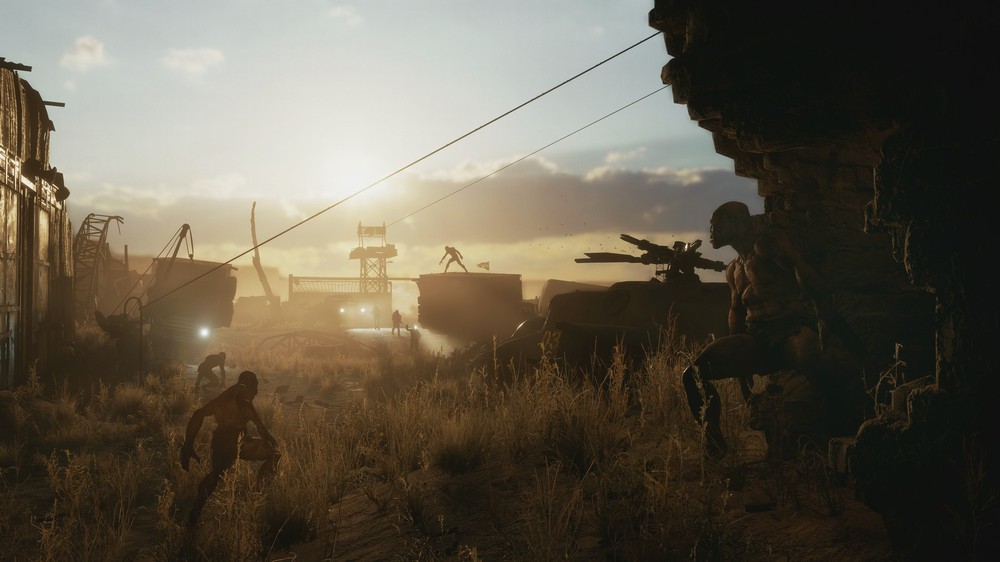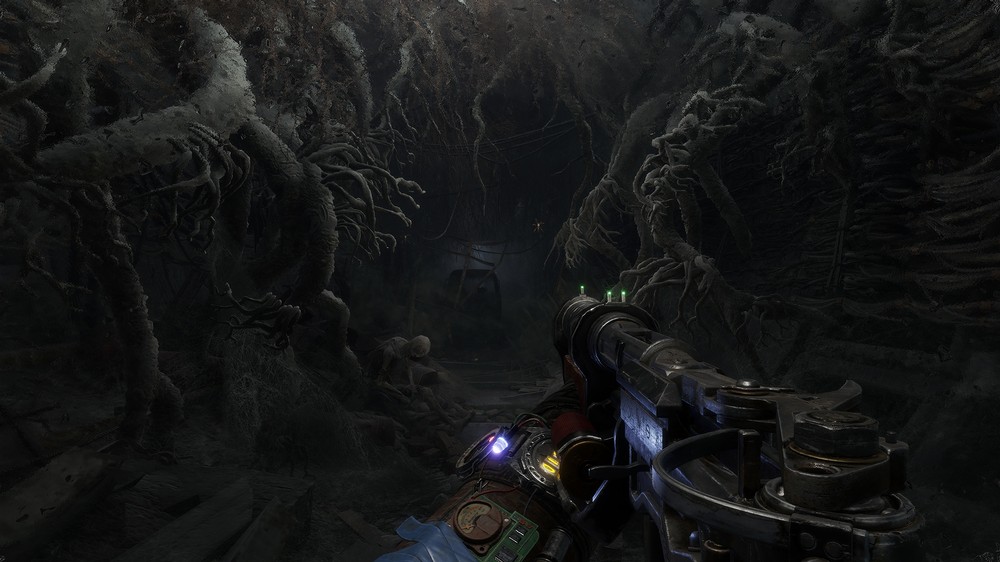Not only am I a big fan of the Metro game franchise, I’m an even bigger fan of Dmitry Glukhovsky’s novels that inspired the games. I generally prefer multiplayer and team-based games but when the opportunity to play and review Metro Exodus presented itself, I jumped at the chance to experience this single-player, third installment in the Metro survival series, and I was not disappointed.
The story of Exodus is divided into four parts, each distinguished by a season and kicking off with a bitter cold prologue in the all too familiar ruins of Moscow where we meet up with our hero, Artyom who is out on routine patrol. This initial chapter is the shortest of the four, mainly designed to setup and familiarize us with all the main characters that will be joining us for the remainder of the adventure. It’s also a good time to learn or relearn the intricacies of the scavenging, crafting, and resource management that forms the core of Metro. The chapter culminates in our band of heroes stealing a train and smashing their way out of Moscow.
For the remaining 20-30+ hours (depending on how thorough you explore) prepare to embark on one of the more realistic survival sandbox games I’ve played in recent years. I’ve done quite a bit of survival training and exercises in real-life and while admittedly simplified for gaming purposes, this still comes off as quite realistic with all sorts of intertwining systems and shared resources. Crafting is based on two primary resources you gather while exploring the land and looting your enemies. You can perform limited crafting at any time by using your backpack to assemble med kits, air filters, and pneumatic air rifle rounds. More elaborate crafting such as other ammo types or repairing weapon damage can only be done at a workbench.
The rules of the game are sophisticated in favor of realism. You can’t carry around six weapons at a time; only three, and if you want to swap you either have to do this at a workbench or make a swap with a fallen enemy or loot drop. The clever element lies in the customization of weapons which can be done using backpack crafting. You can go into any weapon and start swapping out any available parts, adding compensators, suppressors, extended mags, a variety of sights and scopes, and even stocks for stability. By mixing up the parts you can turn any weapon into a silent scoped assassination weapon, or a flashy fully automatic Rambo weapon that will instill fear into the mutant hordes. This level of customization encourages players to analyze each encounter and prep their arsenal appropriately, and even your comrades might suggest a stealth approach when the odds are against you, which is almost always.
Weapons get so much attention in this game with the ability to swap or field strip a weapon for parts and ammo with a choice of button presses. I particularly enjoyed the damage model applied to weapons, so if you are using them during a sandstorm or getting them wet or dirty the guns will jam or not be as effective, forcing you to spend valuable crafting resources to clean them back to optimum performance. There is nothing worse than having to decide whether to clean your gun or make an extra med kit.
Also in need of frequent repair is your gas mask, which slowly becomes damaged when wearing it in combat. You’ll slowly see cracks and chips and eventually holes appear making the mask less efficient and eventually worthless as you gasp, blackout, and die. Thankfully the mask doesn’t play as much of a critical role as it did in past games. Once outside of Moscow much of the game is radiation free, and you are only forced to wear the mask in certain hot zones or during violent sandstorms. As long as you have a mask in good condition and four minutes of filters prior to any mission you should be fine. 
Metro Exodus can best be summed up with a single word – “excess”, which is both good and bad. The level and world design is excessively detailed, which makes the game stunning to behold on the Xbox One X with full HDR and 4K support, but the levels are so littered with clutter that it can make things a bit sticky when trying to move around, and it’s not always obvious or predictable on what you will or will not get stuck on when trying to flank or flee. It also creates some annoying targeting issues when aiming through a hole in the wall or through a shelf of items, as it appears you have a clear shot, but the bullet won’t pass through the cluttered cover.
Perhaps the most excessive element in Metro Exodus is the script. People love to talk and often at the same time. There are numerous moments of regrouping and relaxation where you will get to chat up the various people in your group of survivors. Often you don’t even have to hit a button; just approach and they will go off on an 8-10 minute monologue. Keep in mind you never speak, so this is very one-sided, and you are never sure if what they are saying is important exposition or merely atmospheric fluff. Turning on subtitles will still display text even when you are out of audible range, and some mid-mission conversations will dynamically switch between positional audio and digital com chatter if you move too far away, which was a nice touch. The biggest chatterbox is your wife, Anna who will talk for as long as you want to listen, but at least you get some side activities like caressing her shoulder, drinking coffee, or smoking a hand rolled cigarette. 
Metro Exodus starts off rather linear but quickly turns into an open-world survival sandbox where primary and secondary missions are displayed on the map, and you are free to tackle them in the order you choose. Obviously the secondary (?) objectives usually help to better equip you for the primary (X) mission as was the case during the first stop where I was hunting down a missing teddy bear and guitar before tackling that mutant catfish inside the train yard. The missions are realistically designed to fit the environments and the overarching story, and the use of a day/night cycle allows you to further customize how you play. During the day you get a certain set of enemy encounters, but at night all new horrors come out to play. You have to weigh the added stealth elements versus the deadlier creatures of the night then choose to sleep in a bed until the desired time.
The various chapters also feature their own style of gameplay. The first stop is a nice mix of stealth and survival while the second stop at a government bunker switches into a survival-horror FPS game, and later on, when you reach the desert, the game takes on this Mad Max vibe where you are mowing down mutants in a rusty minivan. And gameplay takes a huge twist in the final chapter where you basically start over with a crossbow, as you run recon for your future forest home. Metro Exodus always seems to offer something new and exciting at every twist of the tracks.
Presentation is outstanding, and while this is only my second major title I’ve played on my new Xbox One X, I can tell you it is already worth the system upgrade. The 4K visuals and HDR lighting combine for some truly photo-real moments, and the framerate and smooth targeting makes the shooting fun and as accurate as these handcrafted weapons should be whether using iron sights or a 4x scope. Even the rechargeable flashlight and the night vision goggles had realistic visuals and illumination. I also appreciated the use of your wristband for important game info keeping the game HUD-free. Combined with fantastic sound effects for weapons, environment, and terrifying mutant creatures and survivors and hundreds of hours of recorded dialogue for characters who affectionately won’t shut up, Metro Exodus is a masterclass of immersive gameplay.
The only thing that disrupted that immersion was some super-long load times and numerous game freezes. On average, standard load times from a fresh start of the game took 3-5 minutes with the game loaded on a 2TB WDC external USB drive. On suggestion I moved the game to the internal drive and load times dropped to 2-4 minutes. This is nearly every load and loading a new chapter/location often exceeded 4-5 minutes. The game allows for quick saves and quick loads, and while saving was instant a quick load would take 60-90 seconds. This problem was further exasperated by the countless times the game froze; only they weren’t countless. I documented them all and by the time I reached the final forest chapter the game had frozen 38 times. At first it was once or twice per hour but during the Caspian desert level it was freezing 3-4 times per hour forcing me to quit the game and restart. Resetting the system, clearing the cache, and even deleting and reinstalling the game has had no effect. The lockups are totally random. It locked up climbing a ladder, driving a van, and even listening to the radio that you play with in your quarters. Thankfully this hasn’t forced me to replay significant portions of the game, but I am forced to endure those long load times every time I restart. I can only hope the load times and game freezes are addressed in a future patch.
We’re only two months into 2019 but Metro Exodus has quickly become my favorite game of the year. From the realistic survival and crafting mechanics to the painstakingly detailed apocalyptic world, Exodus not only tells a fantastic story, it totally immerses you in that story in a way no other single-player survival game ever has. The somewhat annoying minutiae of all those systems from the first two games have been polished and perfected with numerous quality of life enhancements that bring back the joy of run and gun crafting, making Metro Exodus a must-own game for any fan of the Metro franchise or anyone looking for a good story-rich, survival horror game.












I liked your review and agree about some of the bugs, and the NPC chatter. I enjoyed it my first playthrough, but going back and replaying chapters to pick up diaries and postcards, I just walked away from the blah blah blah. I was able to get the Forest Child achievement on the Taiga level.